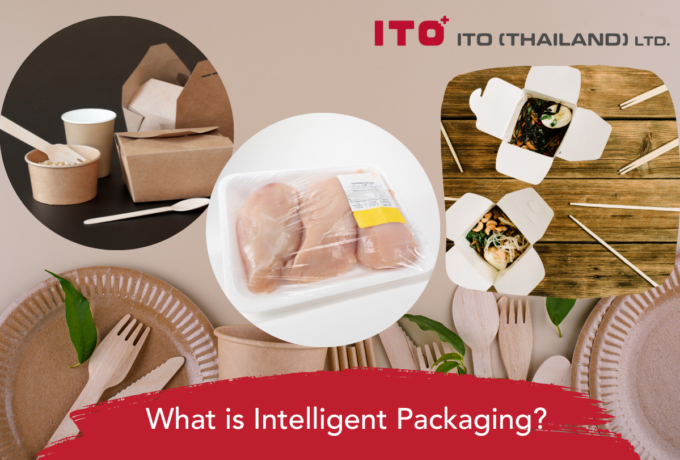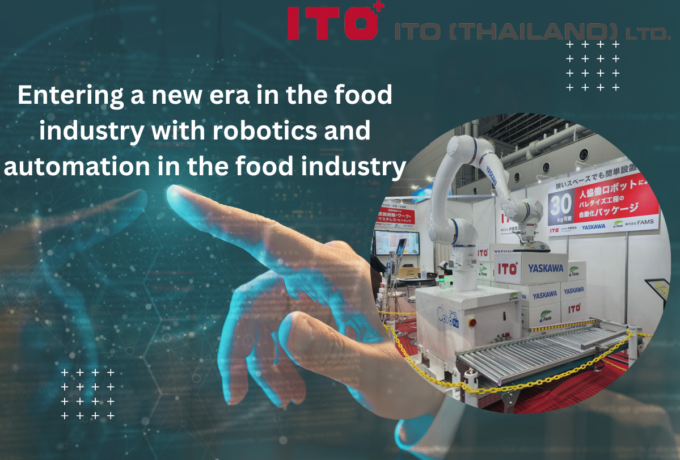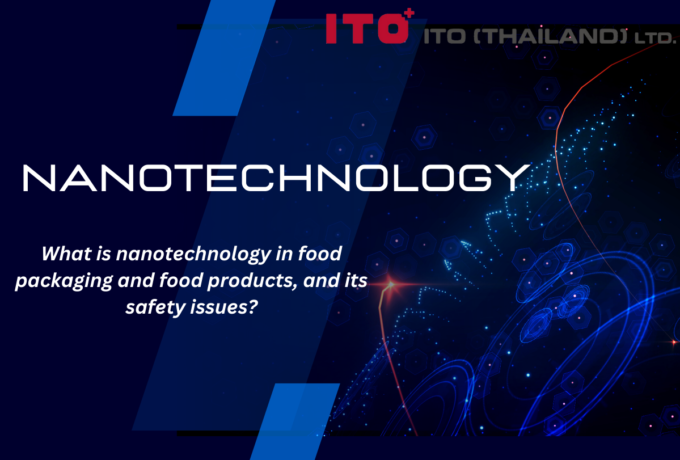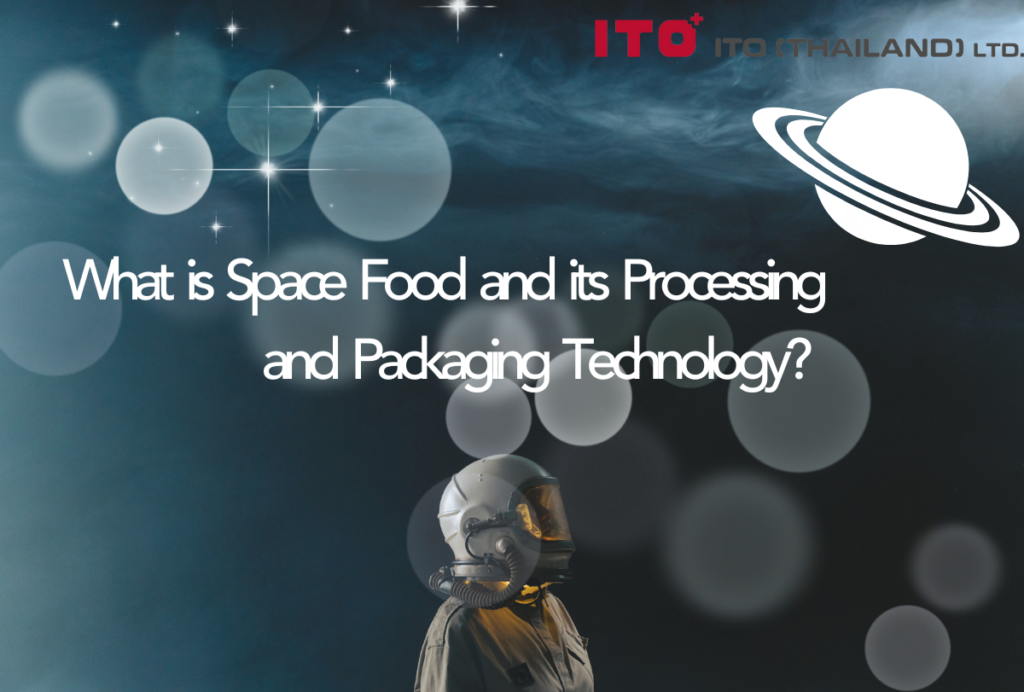ITO Thailand Hygiene Blog
Space Food (Part 1)
In recent years, there has been a number of research in regard to foods for long-term transport. We have discussed that some types of food, such as 3D printed food, are customisable and able to create personalised meals. Doubtlessly, it is capable of long-term missions such as aerospace and military applications. Space food, its processing and packaging technology, as well as space food and waste management will be discussed in this blog.
What is Space Food and its Processing and Packaging Technology (3)
Space food is a kind of special food manufactured and formulated for a zero-gravity environment, for astronauts since the 1980s. The big difference between space food and normal meals is its customised nutrients, to help astronauts stay healthy during a long space mission, as well as palatability. Apart from a nourishing meal, it also consists of special attributes such as being compact, lightweight, easy for transport and storage, remaining stable under extreme conditions e.g., low pressure, radiation, or weightless environment.
There are different types of space food, which can be categorised into rehydratable food, thermo-stabilised food, intermediate moisture food, natural form food, irradiated food, frozen food, fresh food, and refrigerated food (5). The most desirable types are rehydratable food, also known as freeze-dried food, as it is lightweight, and easy to storage and transport because it only needs water for rehydration prior to consumption, and another type is intermediate moisture food (IMF) which is similar to rehydratable food, but moisture is retained at around 20% to 30%, to prevent microbial growth but still in favour for chemical bonds. IMF is convenient because preparation prior to consumption is not required, so it can be eaten at any time. On the other hand, other types of food require a packaging with an ability to retain their nutritional value, and often heavier e.g., thermo-stabilised food is approximately 4 times heavier than rehydratable food.
Various processing methods have been used, but freeze-drying, food 3D printing, sterilisation by irradiation, microwave assisted thermal sterilisation (MATS), and high pressure processing (HPP) are in favour with aerospace food processing, as they are capable of maintaining the required qualities. For instance, freeze-drying reduces water content to a minimal level, as it minimises the growth of most spoilage bacteria, thus providing a longer shelf-life. Food 3D printing is also associated with each astronaut’s personal dietary preferences, and their nutritional requirements because everyone has a different needs and health condition. Sterilisation, either irradiation or microwave-assisted thermal sterilisation, aims to inactivate spoilage microorganisms. The main dissimilarities between them are irradiation sterilisation doesn’t rely on heat, so most nutrients, flavours, and qualities of food are retained. However, microwave-assisted thermal sterilisation usually combines with another processing method, to reduce the severity and potential damages to food quality and flavours caused by heat.
Moreover, after a series of processing, an appropriate packaging material must be considered as well to maintain the optimum condition of food, suppressing nutritional deterioration, as well as controlling oxygen and moisture permeability. Edible film, retort pouch, and high barrier packaging are the most preferable packaging because they tick all the boxes as well as providing a safe, and healthy appetite.
Space Food and Waste Management (2,4)
Managing a sufficient food supply on a lengthy mission is quite challenging, while growing food on a spaceship also requires energy and water. So, scientists have studied anaerobic digestion to break down human waste into nutritive foods. This novel discovery is still in the early development phase, but it is possible as methane gas will be produced from anaerobic digestion, and beneficial microbes (Methylococcus capsulatus) use methane gas to produce animal feed. Thus, it has a high potential to develop into human food as well.
During long-duration space missions, a huge number of trashes and food wastes are unavoidable, for instance, a year mission with 4 astronauts can generate 2.5 tonnes of waste. Currently, there are 2 methods for waste disposal, which are storage in a dedicated vehicle and either bring them back to earth or burn them in the atmosphere. A long-term trash deposit impacts the health and well-being of astronauts and could pose health hazards as well. NASA has been challenged by this matter for a period of time, but the most reliable management method is recycling. With a high-temperature reactor, wastes can be transformed into useful resources such as water, or oxygen. However, it is important that astronauts live in a sustainable way, so last year NASA asked for public help if a better and effective waste management solution can be used on a space mission, which may be as long as 3 years (1). As previously discussed, waste management is the key for a sustainable food industry, and way of life.
Space food can be considered as novel food, as more research and development are necessary as well. There are more issues to be discussed, so new space food technology and future opportunities will be discussed in the next blog, space food part 2.
References
1.Clark, S. (2022). Nasa asks public to help solve waste recycling for Mars trip. The Guardian. Retrieved January 23, 2023, from https://www.theguardian.com/science/2022/jan/29/nasa-asks-public-to-solve-waste-recycling-mars-trip
2.Gabbatiss, J. (2018). Human waste used to make ‘Marmite-like’ food for astronauts. The Independent. Retrieved January 23, 2023, from https://www.independent.co.uk/news/science/astronauts-food-human-waste-marmite-iss-international-space-station-nasa-a8179451.html
3.Jiang, J., Zhang, M., Bhandari, B., & Cao, P. (2019). Current processing and packing technology for space foods: a review. Critical Reviews in Food Science and Nutrition, 60(21), 3573–3588. https://doi.org/10.1080/10408398.2019.1700348
4.Lockhart, L. (2018). Waste Handling in a Microgravity Environment Challenge. NASA. Retrieved January 23, 2023, from https://www.nasa.gov/feature/recycling-in-space-waste-handling-in-a-microgravity-environment-challenge/
5.Raut, S., Hegde, S., Modak, S., & Bhande, R. (2021). Advancements in Space Food Processing Technologies. International Journal of Recent Scientific Research, 12(06), 42033–42037. https://doi.org/10.24327/ijrsr
Related Post
-

Biodegradable Packaging
As straightforward as its name, it means any packaging that will naturally fall apart and decompose. In recent years, biodegradable packaging has been included as one of the sustainable development goals for several organisations. A similar issue, bioplastics, an alternative to sustainable living, was discussed in a previous blog. However, there are some differences between them. For example, bioplastics are made from raw materials sourced from renewable and natural sources and could or could not be biodegradable. In contrast, biodegradable plastic can naturally degrade through living organisms no matter the source material it originates from. The development history of biodegradable packaging, frequently used materials, the pros and cons of biodegradable packaging, and its future trends will be discussed in this blog.
-

Precision Agriculture
Precision agriculture has revolutionised how we approach crop management by optimising the inputs to meet specific requirements. Even though it is not a new system, recent technologies have made it possible to apply it in practical productions. In this blog, we will discuss the definition of precision agriculture, its pros and cons, and future trends.
-

Vertical Farming
Agriculture has utilised nearly all the available land, causing growing difficulty in finding land on the earth’s surface. With limited resources, meeting the world’s food demands will require more innovative and dependable methods of producing safe food, and the answer lies in vertical farming.
-

Intelligent Packaging
Without packaging, food products would last for only a short period of time, impossible for logistics management, difficulties in the supply chain system, quick quality deterioration, and prone to contamination to risky foodborne pathogens. In reality, there are many more functions that packaging is contributing to food products, as well as many types of smart packaging. Intelligent packaging is considered to be a part of smart packaging, so in this blog, we will discuss the contribution of intelligent packaging to food products.
-

Robots & automation in the food industry
Entering a new era in the food industry with robotics and automation in the food industry
-

Nanotechnology in the Food Industry
Nanotechnology has been brought to our attention for the last decades, and it has provided various beneficial applications to the food industry. Unlike other technology, nanotechnology has broadened the knowledge in the food industry to another level in a nanoscale dimension. It involves almost every aspect of the food industry, including food packaging, food processing, as well as functional food development and enhancement of food safety. In this blog, we will discuss how nanotechnology is used in food packaging and food products, and the most important part, its safety issues.










